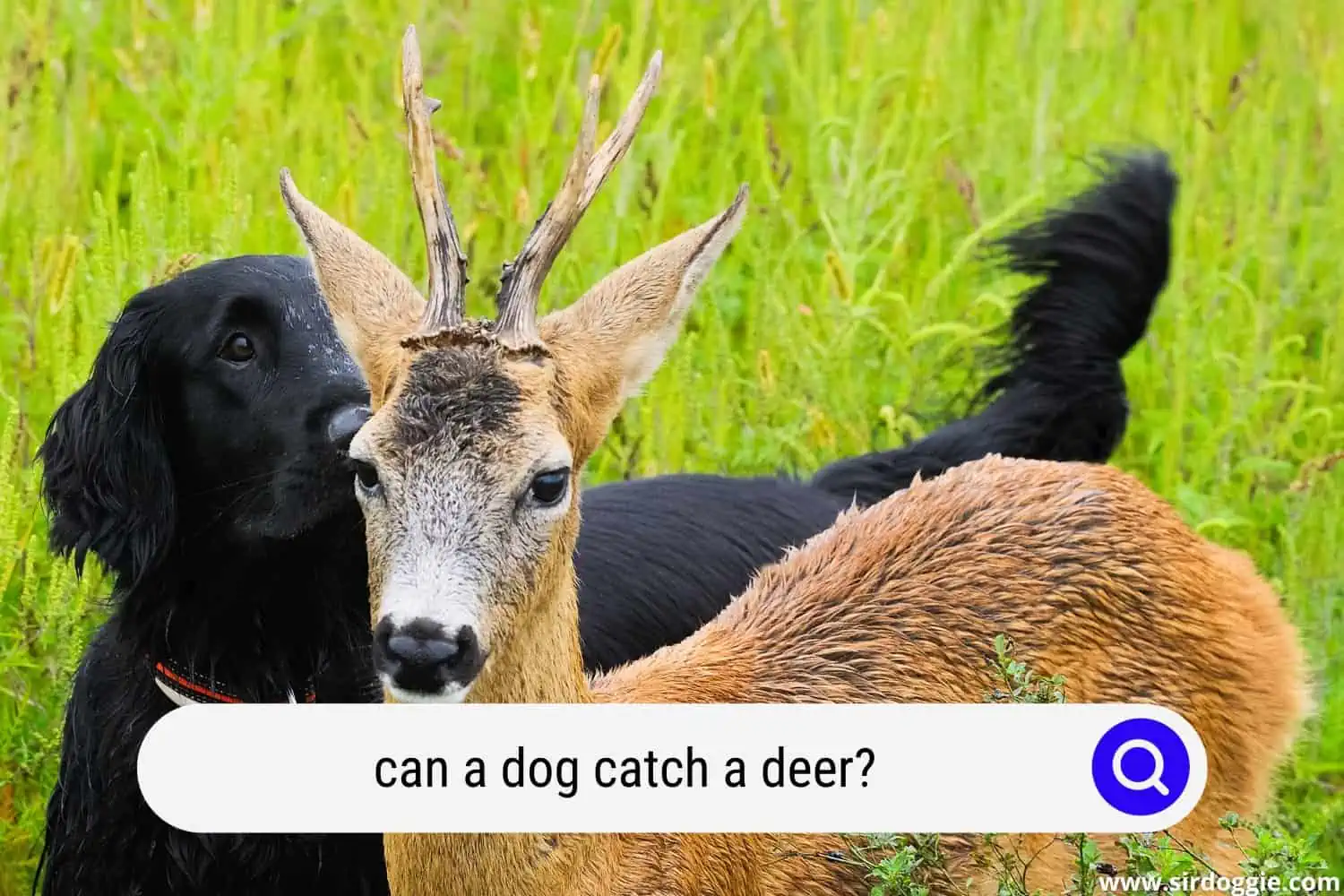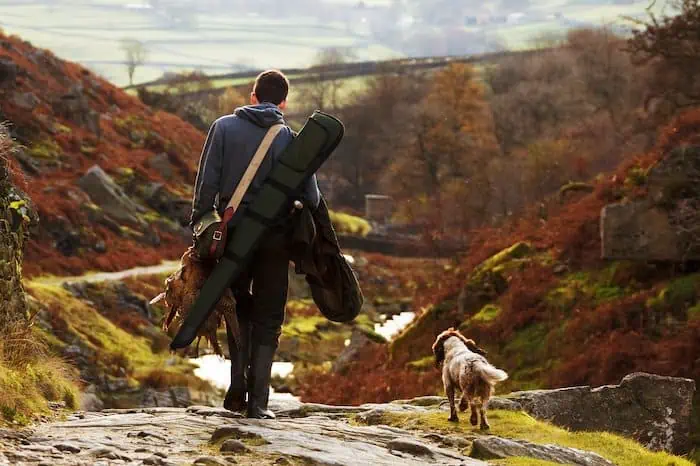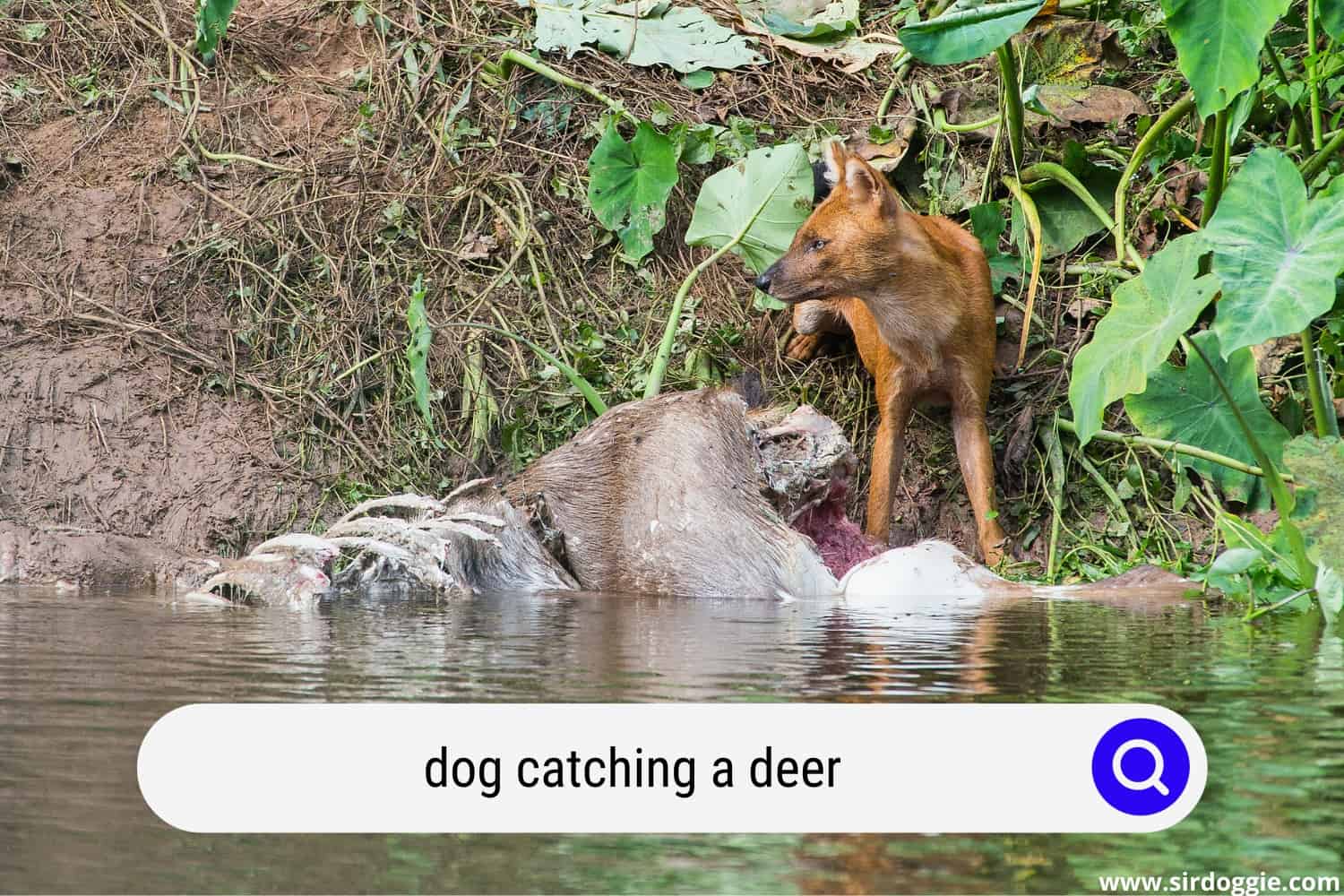Can a Dog Catch a Deer? (Explained)
Dogs play various and vital roles in our lives. They are guardians, friends, entertainers, and providers all at the same time. In the past, dogs were also crucial partners for people on the hunt for their food. However, could a dog catch a deer?

A dog chasing a deer to catch it is not a common occurrence—but if you’re talking about a dog’s capability to do so, then yes, a dog can catch a deer. Not all dogs can catch deer, but some breeds are fully capable of doing so, such as the Labrador Retriever, German Shorthair Pointer, English Setter, and hounds of all types. The impressive sense of smell, quickness, persistence, and ability to navigate all types of land has enabled dogs to hunt down animals—including deer—and people have used them when needing to catch deer in the past.
If you’re new to this information, it simply refers to the history and practice of trapping deer using carefully bred and trained dogs in the exercise of deer hunting.
Deer hunting
Although humans no longer rely on wild game for sustenance, hunting and catching still have a place in this modern world. As agriculture and animal production have improved, new food sources have emerged, reducing human reliance on killing animals for survival.
Instead, catching deer and other wild animals has evolved into a game. Although deer hunting is a contentious topic, many humans and their canine partners participate in the game respectfully and responsibly that improves their bond.
Related Reading: Can A Dog Catch A Squirrel? (Here’s The Answer)
How does a dog catch a deer?
A deer is an incredibly quick animal, and a dog often just cannot compete with it—at first. However, dogs are long runners and have the stamina to run for longer periods, which is highly beneficial when it comes to tracking down quick prey or targets. This is when their stamina overcomes that of a deer and they are then able to assist their human partners in the hunt.
When a dog owner locates a deer to catch, the dog will approach the deer to begin the chase. A deer’s speed is quick at first, but as time passes, it slows down. As dogs are more able to sustain their speed for extended periods by comparison, this then allows them to draw closer to the deer over time.
Furthermore, both the dog and the owner must devote time to tracking as well as receiving a proper education on how to safely hunt, catch, and navigate their outdoor environment. Forest training exposes young dogs to a variety of different conditions, such as the forests themselves, water sources of varying types and intensities, the different trees, and also climate variations. With practice and constant exploration, they learn to avoid harmful insects and other dangers, learn to swim in both warm and cold water and become desensitized to those temperatures, strategically track and stroll through long grass, and deal with a variety of other challenges.
This education and experience help them get ready for a true chase as they advance and when they’ll perform all of those things while focusing on their instructors and the game as well.
What is the best way to teach a dog to catch a deer?
To ensure safe catching, you will need to keep a few things in mind. Catching a deer requires training, which no domestic dog naturally has or knows unless specifically taught. As a result, you first need to provide your dog with some basic training.
Training your dog
A competent hunting dog should have basic obedience abilities as well as specific hunting and catching skills. The foundations of obedience training are very important, including such common “tricks” as sitting, staying, and coming when called. Dogs are always interested and ready to adapt to nature, making them the ideal pets for training and continued learning.
Additionally, your dog must be exposed to different sights, sounds, smells, animals, people, and locations from the earliest age possible and long into adulthood.
Exposing your dog to the world of animals
Your dog can be exposed to local wildlife on a walk, in a nearby park, or in nearly any other outdoor setting you may take him to. Birds, deer, rabbits, wolves, and even other dogs will stimulate his curiosity about this world, and it’s good to get him comfortable and desensitized to all of the unusual sights, sounds and smells of the areas shared with other animals in the world. If offered in your area, you may want to consider joining a hunting and catching club to identify the greatest outdoor areas for sport or simply for adventure, especially if you aren’t familiar with nor know of any outdoor sites to take your dog to practice and learn.
Learning about your dog during puppyhood
Having a cute puppy is an exciting time in your life, so take advantage of it and develop a strong relationship with your dog. It is key for a dog to trust you as his or her best friend.
It is also crucial that you understand your dog’s personality and abilities. This allows you to better understand how to train and instruct your dog as well as understand if there are any difficult areas when practicing new skills. When you see his or her talents grow, stamina improve, and ability to focus improve, you will be both amazed and incredibly proud of the dog you’ve raised since being a small puppy.
Basic veterinary care for hunting dogs
As with any dog, be sure that all of your dog’s vaccinations are current. Stay on top of monthly preventatives to prevent heartworms and intestinal parasites—more than the average house dog, it will be exposed to parasites in the outdoors. Also, medications for external parasites like fleas and ticks should be maintained every month as well since these risks are also increased by a dog spending far more time outdoors than the average pet.
Provide your dog with specific hunting/catching training

Aside from basic obedience skills, specific hunting and catching skills must also be taught to dogs that will be participating in these sports/games. These lessons will typically cover tracking, retrieval, and several gestures that will vary between bird dogs and sniffer dogs. Professional trainers are available to help with hunting and catching training to ensure your dog learns the appropriate skills and how to safely execute all commands in a true hunting and catching situation.
General safety for hunting dogs
When out in the outdoors, allowing a dog to have water from a pond is never a good idea. To avoid intestinal discomfort, drink bottled water or bring water from home. For convenience, collapsible and portable dog bowls are now readily available online and in stores to help you safely provide clean water for your dog when out on an adventure.
Also, it’s wise to keep a first aid kit with you containing hydrogen peroxide, antibiotic ointment, and bandaging materials. Be sure to have the contact information for an emergency veterinary clinic on hand too in case of an emergency.

Related Questions
Which breeds of dogs are employed to hunt deer?
There are quite a few dog breeds that are suitable for deer hunting. Bird dogs, deer hunting dogs, and hounds are examples of these breeds—deer can be hunted with all three of these, and each category includes multiple different standard dog breeds. However, there are varying rules depending upon the location on which types of dogs can be used and during which particular hunting seasons.
Is a deer an aggressive animal?
Deer are not known to be violent in their natural habitats. They are more prone to hide or escape if they are approached by predators or other animals. In rare cases though, they can be aggressive when they are harmed, intimidated, or feel threatened.
Why do dogs chase deer?
Even though dogs have generally learned to ignore deer-scented trails, many may still chase deer simply for the sake of indulging their instinct to hunt something moving quickly away from them. Take your dog with you when you pass through an area with a lot of deer to teach it not to chase based solely on getting triggered by significant quick movement.
Related Reading: Can Dogs Catch Fish? (A Detailed Explanation)

Family Dog Expert Author
Hi there! I’m Stuart, a devoted dog lover and family dog expert with over a decade of experience working with our furry companions. My passion for dogs drives me to share my knowledge and expertise, helping families build strong, loving bonds with their four-legged friends. When I’m not writing for SirDoggie, you’ll find me hiking, playing with my beautiful dog, or studying music.